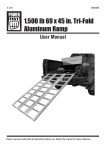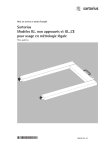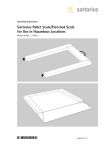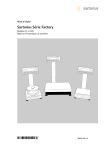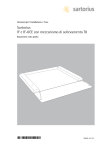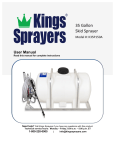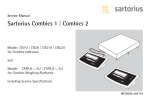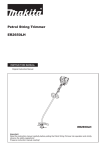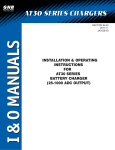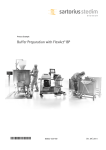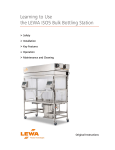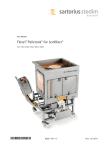Download Platform User Manual - Precision Weighing Balances Presents
Transcript
Installation and Operating Instructions Sartorius IF.. Standard and IF...CE Verifiable Models Flat-bed Scale 98648-012-37 General View of the Equipment 2 4 1 3 5 6 1 2 3 4 5 6 2 Weighing platform Handles|guide bars Level indicator Drive-on ramp Load cell with load-bearing foot Junction box Contents 2 General View of the Equipment 3 Intended Use 3 Warnings and Safety Precautions 4 Installation Instructions 4 Installation 6 Connecting the IF.. Flat-bed Scale 8 Care and Maintenance 9 Specifications 9 Accessories (Options) 9 Dimensions (Scale Drawings) 10 Declarations of Conformity – – The following symbols are used in these instructions: § indicates required steps $ indicates steps required only under certain conditions > describes what happens after you have performed a particular step – indicates an item in a list ! indicates a hazard – – Intended Use The weighing platform is a component of a modular scale, consisting of the weighing platform and an indicator (which is comprised of an analog/digital converter and a display and operator terminal); e.g., a Combics CIS indicator or a QCT01 terminal. Each component comes with a separate installation and operating manual. Note: The verifiable models (“-.CE”) can be verified for use as a scale only when connected to a display and control unit/indicator. Read the installation and operating instructions carefully before connecting the IF.. weighing platform and putting it into operation. For the User – Always make sure the equipment is disconnected from AC power before performing any installation, cleaning, maintenance or repair work on the scale or weighing system. – If you see any indication that the scale cannot be operated safely (for example, due to damage), turn it off and lock it in a secure place or otherwise prevent use of the equipment for the time being. Warnings and Safety Precautions Note: Improper use or handling can result in damage and|or injury. The flat-bed scale may be installed and operated by qualified personnel only. Make sure you observe the warning and safety information in its entirety during installation and operation, as well as while performing maintenance and repair work on the equipment. The standards, regulations, occupational safety requirements and environmental protection laws valid in your country must be observed. It is important that all personnel using the equipment understand this information, and have access to the relevant documents at all times. Furthermore, the warning and safety information supplied with any electrical equipment connected, such as peripheral devices, must be observed as well. These warnings and safety precautions may have to be supplemented by the equipment operator. All operating personnel must be informed of any additions to these instructions. Make sure the equipment is accessible at all times. General Provisions for Installing IF.. and IF.. CE Models The IF.. and IF...CE models meet the EC Directives for electromagnetic compatibility and electrical safety. The IF.. and IF...CE models are not approved for use in hazardous areas, medical facilities, nor areas exposed to potentially explosive materials. Operating the IF.. and IF...CE models beyond the restrictions indicated is not permitted, and is considered use of the equipment for other than its intended purpose. Any installation work that does not conform to the instructions in this manual will result in forfeiture of all claims under the manufacturer’s warranty. If the equipment housing is opened by anyone other than persons authorized by Sartorius, this will negate its conformity with regulations governing its use and result in forfeiture of all claims under the manufacturer’s warranty. Installation of the display and control unit/indicator must be performed by a certified electrician who is familiar with the assembly, start-up and operation of the system and with the relevant guidelines and regulations, and has the required qualifications for performing the installation. If you need assistance, contact your Sartorius dealer or the Sartorius Service Center. If no interface cable is connected, place a protective cap over the female interface connector. – – – – Note: If the scale has been verified, the seals affixed to the equipment indicate that only authorized service technicians are allowed to open the scale and perform maintenance work, so that safe and trouble-free operation of the equipment is ensured and the warranty remains in effect. (IF...CE models can be verified for use in legal metrology only when connected to a display and control unit/indicator, such as the Combics indicator, isi display and control unit, or QCT terminal). If any of the verification seals are damaged, make sure to observe the national regulations and standards applicable in your country in such cases. In some countries, the verification becomes null and void and the equipment must be re-verified. Chemicals (e.g., gases or dusts) that can corrode and damage the inside or outside of the device must be kept away from the equipment. Handle the equipment and any accessories in accordance with the IP rating (IP65 or higher) and EN 60529. The casing on all connecting cables, as well as the casing on wires inside the equipment housing, is made of PVC. Chemicals that corrode this material must be kept away from these cables. The casing of the power cable is made of rubber. Do not expose the scale to aggressive chemical vapors or to extreme temperatures, moisture, shocks, or vibration. The allowable operating temperature range is –10°C to +40°C (+14°F to +104°F). Make sure the place of installation is adequately ventilated to prevent build-up of excessive heat. If you use cables purchased from another manufacturer, check the pin assignments in the cable against those specified by Sartorius before connecting the cable to Sartorius equipment, and disconnect any wires that are assigned differently. The operator shall be solely responsible for any damage or injuries that occur when using cables not supplied by Sartorius. Use only genuine Sartorius spare parts. 3 Installation Instructions Unpacking the Equipment § Please read the enclosed operating instructions carefully before putting the scale into operation. § After unpacking the equipment, please check it immediately for any visible damage. $ If you detect any damage, proceed as directed in under “Safety Inspection” in the chapter entitled “Care and Maintenance.” $ It is a good idea to save the box and all parts of the packaging until you have successfully installed your equipment. Only the original packaging provides the best protection for shipment. $ Before packing your equipment for shipment, unplug all connected cables to prevent damage. Equipment Supplied – IF.. weighing platform – Installation and operating instructions Requirements for the Place of Installation § Observe all safety instructions. The IF.. scale is designed to provide reliable results under normal ambient conditions. When choosing a location to set up the IF.., observe the following so that you will be able to work with added speed and accuracy: – Set up the IF.. on a stable, even surface. The surface directly beneath the scale should be smooth and dry. The load that can be carried by the chosen work surface must be sufficient for both the weighing platform and any load placed on the platform. Level the scale using the built-in level indicator. – – – – – When moving the weighing platform, be sure to observe safety regulations; wear protective clothing (e.g., hardhat, steeltoed boots, etc.). Avoid placing the equipment in close proximity to a heater or otherwise exposing it to heat or direct sunlight. Protect the IF.. from direct exposure to drafts that come from open windows or doors. Avoid exposing the IF.. to excessive vibration. Protect the IF.. from aggressive chemical vapors. Do not expose the equipment to excessive moisture over long periods. Turn off the power when the system is not in use. Installation – The allowable operating temperature range is -10°C to +40°C (+14°F to +104°F). – If there is any indication that the equipment does not function properly (e.g., display remains blank, or no display backlighting) due to damage during transport, disconnect the equipment from power and notify your nearest Sartorius Service Center; see also: “Safety Inspection” in the chapter entitled “Care and Maintenance.” Shock Resistance Even though the IF.. scales feature highly rugged construction, there are some limits. Avoid exposing the system to falling objects, side impact, or shocks. Notes on Integration into Conveyor Systems Any moving or rotating parts intended to be permanently attached to the IF.. scale must be designed so that they cannot affect the weighing results. For example, rotating mechanisms must be properly balanced. The IF.. must be clear on all sides during weighing so that any dirt or parts that fall will not create a connection between the weighing platform and any permanently mounted preload components. Make sure there are no cables or other objects exerting force on the load plate. Avoid generating static electricity. Using the IF...CE in Legal Metrology in the EU* The type-approval certificate for verification applies only to non-automatic weighing instruments. For automatic operation with or without auxiliary measuring devices or equipment, you must comply with the regulations applicable to the place of installation. Conditioning the Weighing System Moisture in the air can condense on the surface of a cold weighing instrument or other device whenever it is brought to a substantially warmer place. If you transfer the equipment to a warmer area, make sure to condition it for about 2 hours at room temperature, leaving it unplugged from AC power. Afterwards, if you keep the equipment connected to AC power, the constant positive difference in temperature between the inside of the equipment and the outside will practically rule out the effects of moisture condensation. * including the Signatories of the Agreement on the European Economic Area 4 Note: Connection of the scale to a display and control unit/indicator, installation, configuration, and putting the equipment into operation must be performed by a trained dealer or Sartorius service representative. Details on additional settings are contained in the Sartorius service manual. – Unplug the power cord from the wall socket (mains) before performing any work on the equipment. – The special tools indicated must be used when performing installation. – Installation work that affects the IP65 or IP68 protection rating must be performed with extreme care. – Any installation work that does not conform to the instructions in this manual will result in forfeiture of all claims under the manufacturer’s warranty. – When installing the equipment in a weighing system, the EU Directive on Machinery (98/37/EC) must be observed. – Make sure the junction box and load cells do not sustain damage. – Level the scale using the built-in level indicator. Note: Make sure there is a faultless connection between the display and control unit or indicator and the platform (resistance: <1 ohm). The shield must be connected to the cable gland on the A/D converter and to the cable gland on the junction box. IP Rating IF.. scales in the galvanized steel version are rated to IP65; stainless steel versions have IP68 protection. The levels of protection indicated by these ratings are as follows: First digit: rating 6 indicates that the equipment is dust-tight; i.e., completely resistant to penetration by solids. Second digit: rating 5 indicates resistance to penetration by water, including powerful jets of water; rating 8 indicates resistance to ingress of water during complete, continuous submersion in water to a depth of up to 10 meters (approx. 32 feet). IP65 or IP68 protection is guaranteed only if: – the seals on the junction box are installed correctly in accordance with industry standards, and – the connecting cables, protective caps and cable glands were installed and connected by a qualified technician. Affixing Equipment Designation Labels to the IF...CE Equipment designation labels that correspond to configuration of the scale must be affixed to the equipment prior to initial verification. To do this, affix the labels to the display and control unit/indicator or, in special cases, to the plates provided. If plates are required, they are included in the equipment supplied with the display and control unit/indicator. Fasten the plate to the connecting cable between the IF...CE and the display and control unit/indicator. § Affix the label to the plate. Connecting the Scale to AC Power The IF.. scale is powered over the connecting cable from the display and control unit/indicator. Floor-mounting the IF (Option T8) § Remove the floor-mounting bracket from the packaging (included when Option T8 is ordered). § Position the equipment at the desired place of installation. $ Align the stainless steel plates so that they are parallel. § Mark the positions for drilling the required holes, using the floormounting bracket as a template. § Drill pilot holes using your markings as a guide. § Move the bracket and flat-bed scale out of the way and drill the holes for the floor-mounting bracket. § Clean the surface thoroughly. § Position the scale over the holes and affix it in place with the floor-mounting bracket. $ Make sure to avoid putting strain on any part of the equipment! Transporting the IF (Option T7) § Make sure there is no load on the scale. § Remove the drive-on ramp from the front of the scale. $ Make sure to observe the safety instructions. § Remove the threaded caps from the four threaded fasteners and keep them in a safe place. § Attach the two hand cranks to the two threaded fasteners at the front of the scale. § Turn the cranks clockwise to lower the transport rollers. $ Repeat this procedure for the two rear rollers. § The scale can now be moved into the desired position. § If available, fasten the towing bar (optional) as shown. § The scale can now be pulled into the desired position. $ This procedure is useful, for example, for cleaning the surface beneath the scale at the place of installation. § Return the weighing platform to the place of installation and retract the rollers. § Remove the hand crank and replace the four threaded caps. § Fasten the drive-on ramp to the front of the scale. $ Make sure to observe the safety instructions. 5 Connecting the IF.. Flat-bed Scale Connecting Cable: IF.. to Display and Control Unit or Indicator V+ Sense + Signal + Signal – Sense – V– Ground 6 (Supply voltage +) (Supply voltage –) (Output signal +) (Output signal –) (Shield +) (Shield –) (Shield) Cable: type A (white) (brown) (green) (yellow) (pink) (gray) or or or or or or or Cable: type B blue black white red green gray The IF.. Weighing Platforms Example of model designation: IF P P= Painted steel S= Stainless steel 4 1500 RR -LCE Weighing capacity in kg Resolution, not verifiable: 15,000 d = L, 30,000 d = I Verifiable: 3000 e = LCE, 2 +3000 e = NCE Dimensions Load cells 150 50 300 600 1000 000 1500 500 3000 The IF.. Weighing Platforms Galvanized models: – Weighing capacities from 150 kg to 3000 kg – 11 different sizes – 6 weighing capacities – 59 models – 3000 e, 2+3000 e Cl. III (depends on model); 15,000 d, 30,000 d – Surface finishing: painted – IP65 rating – Drive-on ramp – Customized versions possible GG 600 + 600 IG 800 + 600 II 800 + 800 LG 1000 + 600 LI 1000 + 800 LL 1000 + 1000 NL 1250 + 1000 NN 1250 + 1250 Stainless steel models: – Weighing capacities from 150 kg to 3000 kg – 11 different sizes – 6 weighing capacities – 59 models – 3000 e, 2+3000 e Cl. III (depends on model); 15,000 d, 30,000 d – Material/surface finishing: AISI 304 or AISI 316 Ti stainless steel, brushed or electropolished – IP67/IP65 rating – Stainless steel load cells – Drive-on ramp; customized versions possible RN 1500 + 1250 RR 1500 + 1500 WR 2000 + 1500 7 Care and Maintenance Service Regular servicing by a Sartorius technician will extend the service life of your IF.. scale or weighing system and help to ensure its continued weighing accuracy. Sartorius can offer you service contracts, with your choice of regular maintenance intervals ranging from 1 month to 2 years. § Unlock the load plate from the vertical position, use the handle to lower the load plate, and secure the safety catches on the right and left. Repairs ! Disconnect defective equipment from power immediately. Repairs may be performed only by authorized Sartorius service technicians using genuine Sartorius parts. Any attempt by untrained persons to perform repairs may result in considerable hazards for the user. ! If a cable or cable gland is damaged or defective, replace the cable as a complete unit with all its connectors. Cleaning ! Always handle the equipment in keeping with its IP protection rating. Make sure that no liquid enters the IF.. housing. $ Unplug the system from power before cleaning or performing maintenance or repair work. Clean the system regularly to remove all impurities. $ Avoid generating static electricity. Devices rated to IP65 can be rinsed down with a jet of water that strikes the load plate from above. ! When using high-pressure cleaning equipment to clean the IF.. scale, do not point the jet of steam directly at the load cells. > If the water that you use to clean the scale is too hot or too cold, the difference in temperature between the water and the scale can cause condensation inside the scale housing. This condensation can lead to malfunctions in the equipment. Cleaning Beneath the Load Plate (Option T8) Important Note: The load plate must be locked into the vertical position or held in this position by a second person. Warning: Danger of personal injury! Make sure to observe all warnings and the safety precautions. All personnel must wear steel-toed boots while performing work that involves lifting or raising the load plate. § Use the foot switches on the right and left and lower the safety catch. § Use the handle to lift the front of the load plate upwards. Observe all warnings and safety precautions! Important: Lock the load plate into the vertical position. § Clean the area beneath the load plate. 8 Cleaning Stainless Steel Surfaces Clean all stainless steel parts regularly. Use a damp cloth or sponge to clean any stainless steel parts on the system. You can use any commercially available household cleaning agent that is suitable for use on stainless steel. Clean stainless steel surfaces by wiping them down. Then rinse the equipment thoroughly, making sure to remove all residues. Wipe down stainless steel parts again using a clean, damp cloth or sponge. Afterwards, allow the equipment to dry. If desired, you can apply oil to the cleaned surfaces as additional protection. ! Do not use stainless steel cleaning agents that contain soda lye (caustic), acetic acid, hydrochloric acid, sulfuric acid or citric acid. The use of scrubbing sponges made with steel wool is not permitted. Solvents are permitted only for cleaning stainless steel parts. Corrosive Environment $ Remove all traces of corrosive substances on a regular basis. Safety Inspection If there is any indication that safe operation of the IF.. is no longer warranted; i.e.: – If there is visible damage to the connecting cable, – If the device no longer functions properly, – If the equipment has been stored for a relatively long period under unfavorable conditions, or – If the equipment has been subjected to rough handling during shipment, § make sure all safety instructions are observed, and notify your nearest Sartorius Service Center or the International Technical Support Unit based in Goettingen, Germany. Maintenance and repair work may be performed only by authorized Sartorius service technicians who have access to the required maintenance manuals and have received the necessary training. ! The seals affixed to this equipment indicate that only authorized service technicians are allowed to open the equipment and perform maintenance work so that safe and trouble-free operation of the equipment is ensured and the warranty remains in effect. Storage and Shipping Conditions $ The packaging used for shipping your Sartorius equipment is optimally designed to prevent damage during transport. It is a good idea to save the box and all parts of the packaging for future storage or shipment of the equipment. Only the original packaging provides the best protection for shipment. $ Allowable storage temperature: –20°C to +75°C (–4°F to +167°F) $ Allowable humidity during storage: max. 90% $ Please refer to the information under “Warnings and Safety Precautions.” Instructions for Recycling If you no longer need the packaging after successful installation of the equipment, you should return it for recycling. The packaging is made from environmentally friendly materials and is a valuable source of secondary raw material. Contact your local waste disposal authorities if you wish to scrap the equipment. Sartorius AG in Goettingen will take back equipment and packaging for disposal in accordance with the applicable laws.* If you set up the equipment in a country other than Germany, please contact your local waste disposal authorities for information on similar services. * This service is offered only within Germany Specifications General Specifications for the IF-... Models Model IF.. Allowable ambient operating temperature °C –10 to +40 (+14°F to +104°F) IP rating IP65 IP68 (painted models) (stainless steel models) The cables supplied with the weighing platforms as standard equipment are 6 m in length. Capacities: Up to 3000 kg, with restrictions, when the load is distributed on the load plate. Accessories (Options) Order no. Additional drive-on ramps available on request Frame for pit installation available on request For affixing the weighing platform to the floor: Floor-mounting set YFP01I Columns can be manufactured to order on request. Dimensions D W Designation GG IG II LG LI LL NL NN RN RR WR D (mm) 600 800 800 1,000 1,000 1,000 1,250 1,250 1,500 1,500 2,000 W (mm) 600 600 800 600 800 1,000 1,000 1,250 1,250 1,500 1,500 Resolutions Resolution 1 weighing capacity: -L -l -LCE Resolution 2 weighing capacities -NCE 2 +3,000e Resolution: Capacity 1 in g Weighing capacity 2 in kg Resolution: Capacity 2 in g Weighing capacity in kg 15,000d in g 30,000d in g 1+ 3,000e in g Weighing capacity 1 in kg 150 10 5 50 60 20 150 50 300 20 10 100 150 50 300 100 600 50 20 200 300 100 600 200 1000 100 50 500 600 200 1,000 500 1500 100 50 500 600 200 1,500 500 3000 200 100 1,000 1,500 500 3,000 1,000 9 Declarations of Conformity The C marking may be affixed only to equipment that complies with the following Directives (below). Conformity has been tested in conjunction with Sartorius equipment: Council Directive 89/336/EEC “Electromagnetic compatibility (EMC)” as amended by 93/68/EEC Applicable European Standards: 1.1 Reference to 89/336/EEC: Official Journal of the European Communities, No. 2001/C105/03 EN 61326-1 Electrical equipment for measurement, control and laboratory use EMC requirements Part 1: General requirements Defined immunity to interference: Industrial areas, continuous, un-monitored operation Limitation of emissions: Residential areas, IF.... Class A Note: The operator shall be responsible for any modifications to the indicator and for any connections of cables or equipment not supplied by Sartorius. On request, Sartorius will provide information on the minimum operating specifications (in accordance with the Standards listed above for defined immunity to interference). 10 73/23/EEC “Electrical equipment designed for use within certain voltage limits” as amended by 93/68/EEC Applicable European Standards: EN 60950 Safety of information technology equipment including electrical business equipment EN 61010 Safety requirements for electrical equipment for measurement, control and laboratory use Part 1: General requirements Weighing Instruments for Use in Legal Metrology: Council Directive 90/384/EEC “Non-automatic weighing instruments” This Directive regulates the determination of mass in legal metrology. For the respective Declaration of Type Conformity for Sartorius weighing instruments verified for use as legal measuring instruments that have an EC Type-Approval Certificate, see “Declaration of Conformity” in the instruction manual for the connected display and control unit/indicator. This Directive also regulates EC verification by the manufacturer, provided that an EC Type-Approval Certificate has been issued and the manufacturer has been accredited by an officer of a Notified Body registered at the Commission of the European Community for performing such verification. The legal basis for EC verification is EC Directive No. 90/384/EEC for non-automatic weighing instruments, which has been in effect since January 1, 1993, within the Single European Market, and the accreditation of the Quality Management System of Sartorius AG by Lower Saxony’s Regional Administrative Department of Legal Metrology (Niedersächsische Landesverwaltungsamt – Eichwesen) from February 15, 1993. “EC Verification” – A Service Offered by Sartorius Our service technicians authorized to perform the verification of your weighing instruments that are acceptable for legal metrological verification can inspect and verify the metrological specifications at the place of installation within the Member States of the European Union and the Signatories of the Agreement on the European Economic Area. Subsequent Verifications within the European Countries The validity of the verification will become void in accordance with the national regulations of the country in which the weighing instrument is used. For information on verification and legal regulations currently applicable in your country, and to obtain the names of the persons to contact, please contact your local Sartorius office, dealer or service center. 11 12 13 14 15 16 17 18 Sartorius AG Weender Landstrasse 94–108 37075 Goettingen, Germany Phone +49.551.308.0 Fax +49.551.308.3289 www.sartorius.com Copyright by Sartorius AG, Goettingen, Germany. All rights reserved. No part of this publication may be reprinted or translated in any form or by any means without the prior written permission of Sartorius AG. The status of the information, specifications and illustrations in this manual is indicated by the date given below. Sartorius AG reserves the right to make changes to the technology, features, specifications and design of the equipment without notice. Status: November 2004, Sartorius AG, Goettingen, Germany Printed in Germany on paper that has been bleached without any use of chlorine W6A000 · ZPD · KT Publication No.: WIF6002-e04112




















